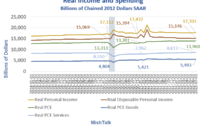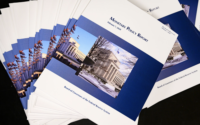Fed’s Balance Sheet Plunges by $230 Billion in 6 Weeks, Biggest such Plunge in 14 Years
Massive gyrations on the balance sheet after FDIC’s take-down of First Republic, sale of its assets to JP Morgan, and FDIC’s loan to JPM.
By Wolf Richter for WOLF STREET.
Today we were served a special spectacle on the Federal Reserve’s weekly balance sheet. Total assets dropped by $59 billion in the week, and by $230 billion in the six weeks since peak bank bailout, to $8.50 trillion, as QT continued on track with a big Treasury securities roll-off, and as First Republic, the FDIC, and JP Morgan were splattered all over this balance sheet.
Looking at total assets with a magnifying glass to see the details of the banking crisis:
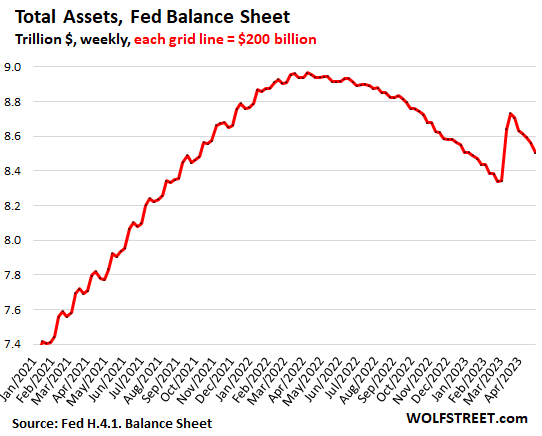
Repos with “foreign official” counterparties: paid off in the prior week. This was likely the program that the Swiss National Bank used to provide dollar-liquidity support for the take-under of Credit Suisse by UBS.
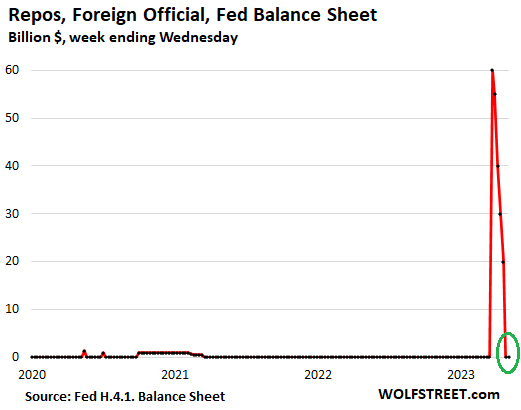
Discount Window (“Primary Credit”): -$68 billion in the week, to just $5 billion.
Since the rate hike yesterday, the Fed charges banks 5.25% to borrow at the Discount Window. Banks also have to post collateral, valued at “fair market value.” This is expensive money for banks that can normally borrow from depositors for a lot less without having to post collateral. It’s where they go when they need a lender-of-last-resort. And when they don’t need it anymore, they pay off those loans.
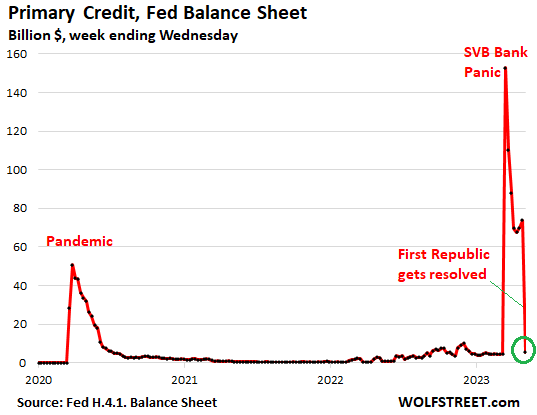
Bank Term Funding Program (BTFP): -$6 billion in the week to $76 billion. Under this program, rolled out on March 13, banks can borrow for up to one year, at a fixed rate, pegged to the one-year overnight index swap rate plus 10 basis points. Banks have to post collateral, but valued “at par.”
Because the BTFP is somewhat less punitive than the Discount Window and provides for one-year funding, there had been a shift in April from the Discount Window to the BTFP. And so we put them on the same chart to see the flows between them.
First Republic’s borrowings at the Discount Window and at the BTFP were paid off after the FDIC resolved First Republic over the weekend and then sold the assets to JP Morgan, which also agreed to take on the deposits and other liabilities. And this is in part what we can see here.
This chart shows both, the loans at the Discount Window (red), which plunged to just $5 billion, and the loans at the BTFP (green), which dropped to $76 billion:
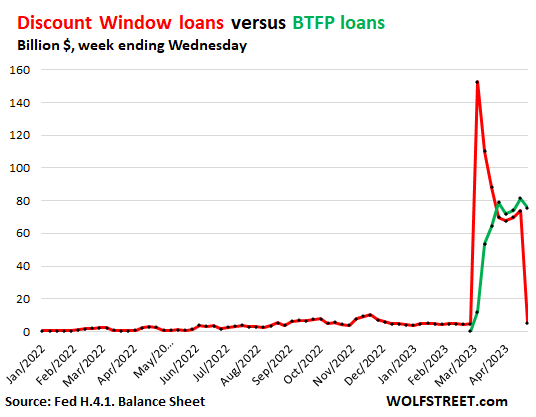
Are you ready for the fun part? Loans to FDIC: +$58 billion in the week, to $228 billion. When JP Morgan acquired the assets of First Republic from the FDIC, it paid the FDIC $182 billion for those assets. The payment came in different forms (we walked through all this in detail here):
- $10.6 billion in cash.
- $92.4 billion by taking on the deposits (liabilities) that are owed the depositors of First Republic.
- $28 billion by taking on the advances First Republic had gotten from Federal Home Loan Banks (FHLB), and which JPM now has to pay off.
- $50 billion loan from the FDIC.
Note the last item. So to boil this down to an example: When you buy a car from a Ford dealer for $50,000, and you pay $2,000 cash down and the dealer arranges a loan through Ford Credit for the remaining balance of $48,000, you will pay $50,000 for the vehicle plus interest over time.
This is kinda what JPM did. It paid some cash down ($10.6 billion), plus it paid a bunch by assuming liabilities that it will have to pay over time to depositors and the FHLB; and it took out a $50 billion loan from the FDIC that JPM will have to pay off over five years.
But just like Ford dealers, the FDIC isn’t sitting on a pile of cash that it can lend out. It seems it went to the Fed and borrowed the $50 billion that it lent to JPM, which then used the cash to pay off the $28 billion in advances by the FHLB and the $30 billion that 11 big banks, including JPM, had put on deposit at First Republic in March to prop it up.
So the FHLB and the banks got their money back, and JPM will now be paying the FDIC the $50 billion plus interest over time, and the FDIC will then pay off the loan it got from the Fed.
This is the kind of stuff that gives a banking crisis such a high entertainment value.
The prior big loans that the FDIC got from the Fed were associated with the bridge banks that it created for the assets and liabilities of Signature Bank and Silicon Valley Bank. The FDIC has made deals to sell a part of the assets and transfer the deposits to other banks. It’s now auctioning off in bits and pieces the mortgage-backed securities (MBS) and Treasury securities that the bridge banks still hold:
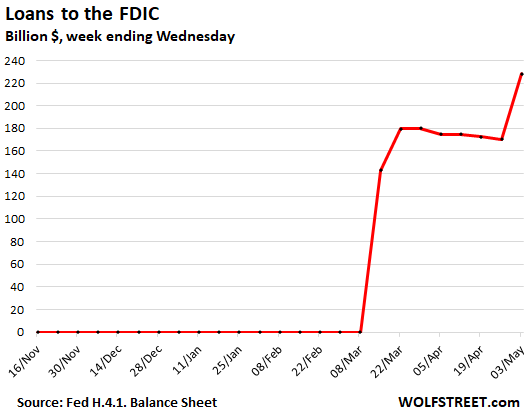
And QT continued:
Treasury notes and bonds: -$49 billion for the week, -$549 billion from the peak in June 2022, to $5.22 trillion.
Treasury notes and bonds “roll off” the balance sheet mid-month or at the end of the month when they mature and the Fed gets paid face value for them. Today’s balance sheet reflects the roll-off at the end of April.
In all of April, $58 billion in Treasury securities rolled off, just under the cap of $60 billion.
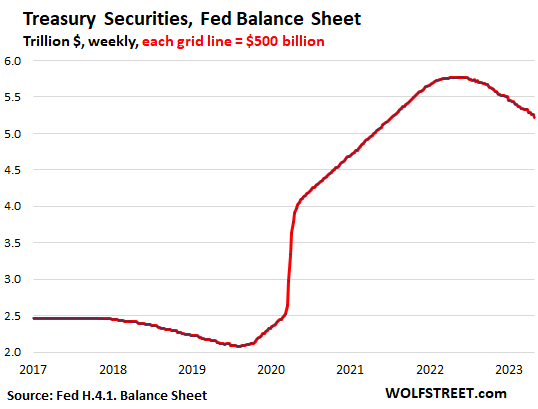
MBS: no change for the week, -$19 billion in April, -$164 billion from peak, to $2.58 trillion. The Fed only holds government-backed “Agency MBS” where taxpayers carry the credit risk.
Mortgage-backed securities roll off the balance sheet primarily through the pass-through principal payments that holders receive when mortgages are paid off, such as when mortgaged homes are sold or mortgages are refinanced, and when regular mortgage payments are made.
The roll-off has been below the cap of $35 billion per month because home sales have plunged and refis have collapsed, and therefore fewer mortgages are getting paid off, and passthrough principal payments to the Fed have slowed:
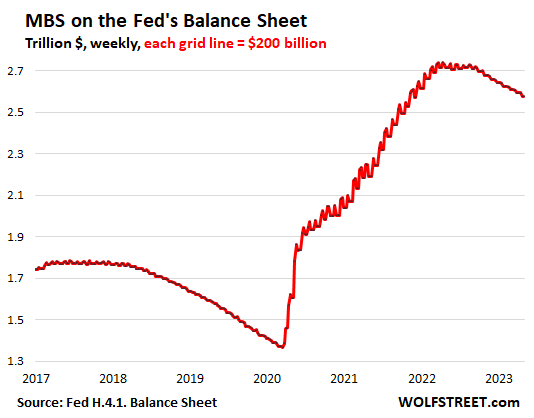
Enjoy reading WOLF STREET and want to support it? You can donate. I appreciate it immensely. Click on the beer and iced-tea mug to find out how:

Would you like to be notified via email when WOLF STREET publishes a new article? Sign up here.
![]()
[ad_2]
Source link

